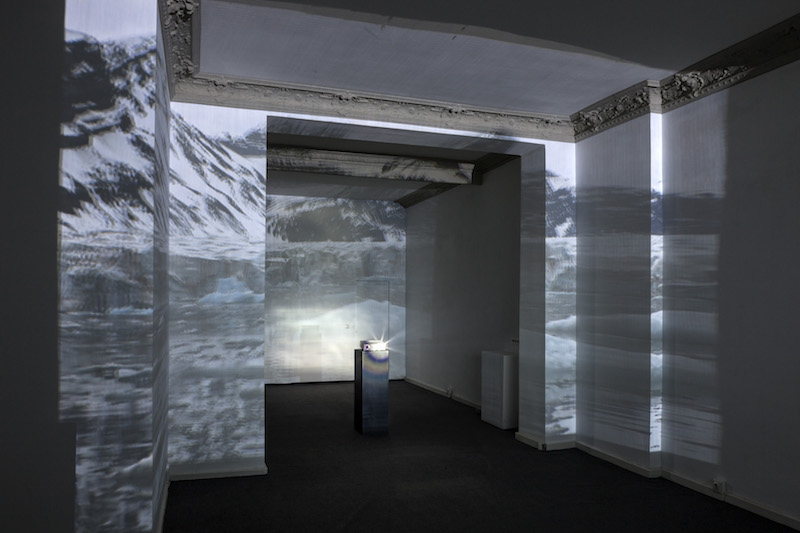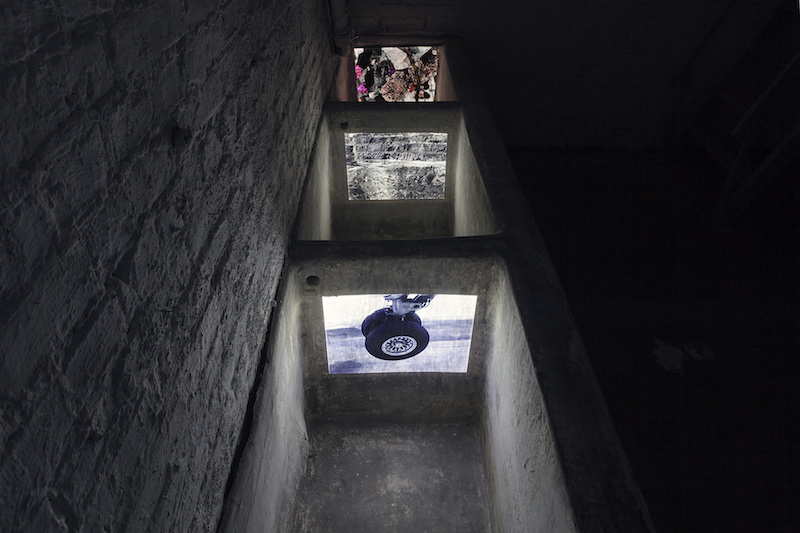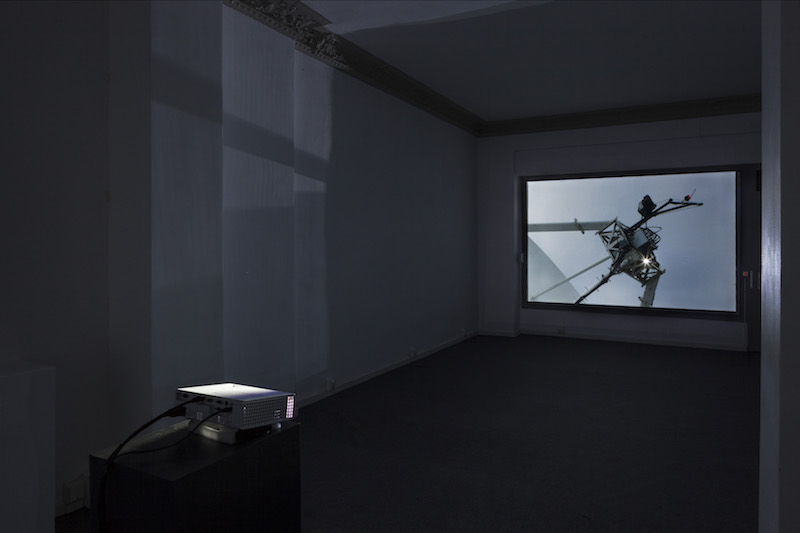“But…what if…the lens itself were an entity? An entity so large that we were utterly dwarfed by it? An entity that we might even be inside of?” Timothy Morton‘s accompanying text to the exhibition Emilija Škarnulytė: ‘MANIFOLD’ at Decad points to the psychological power our environment holds over us. Entwining fiction with documentary, the work of the Lithuanian filmmaker and artist addresses our relationship to climate change, which she does by depicting its existence as bound up with our social imaginary. Her multi-media works provide a complex introspection on the Anthropocene: a line of thinking in which human activity is seen as chiefly responsible for changes in the climate and the environment. In our minds, the planet exists as a celestial body once robust, now moving towards destruction because of human mass-production and activity.
Yet our natural environment endures in another guise, as a figure of our imagination, sometimes even a catastrophic fantasy that we permit ourselves to indulge in. Human impact on the natural environment will continue to exist as a relentless mental burden; environmental demise is both a visible reality and a construct of our consciousness. In her dream-like approach to filmmaking and installation, Škarnulytė demonstrates climate change’s manifestation as a human catastrophe, one that we sometimes choose to relish. Škarnulytė’s work explores this strange dual identity of the Earth, urging us to consider how we may be controlled by our mental perceptions of it.

Emilija Škarnulytė, ‘No Place Rising,’ 2017, 12 min, HD video // Image courtesy of the artist and Decad Gallery, Photography: Julija Goyd © 2017
In the first room, the piece ‘No Place Rising’ is projected onto the back of the gallery’s shopfront window, and reflected back across the room. The imagery of deep sea beds, icebergs and industrial space featured in the film instantly points to the common hysteria of televised documentaries, exclaiming the demise of our planet. Perhaps this is because the majority of its footage was shot in Olavsvern within a classified, 25,000m2 decommissioned Royal Norwegian Navy and NATO submarine base. Yet the sweeping pans of mountains and stark representations of industrial space are devoid of any direct commentary. Their ambiguity, along with Škarnulytė’s knowing manipulation of our viewpoint through tight framing of the imagery, means that you quickly become transfixed by the images. As the film draws to a close, an extended shot of a mermaid-creature (performed by the artist) is shown flapping her way out to sea away from the base. The camera gradually ascends away from her, and the vast expanse of sea-water seems to engulf her.
Looking down at the struggling creature from a great height, we feel trapped within the authoritative gaze of the camera lens. By watching this mythical species negotiate a hostile industrial world, the deterioration of our earth becomes increasingly indecipherable, whether as an immaterial construction, or a very tangible danger. Within these images our imagined human catastrophe becomes bound up with the catalyst of our anxiety, and this musters both fear and excitement. Through generating this response, the industrial space within ‘No Place Rising’ is transformed into a jarringly emotional site, one that bundles guilt and anxiety with a disturbing sense of pleasure. And it is this appreciation of the high production value of Škarnulytė’s films that submerges us within our own imagination.

Emilija Škarnulytė, ‘Hollow Earth,’ 2013, 22 min, 3 channel HD video together with T. Busse // Image courtesy of the artist and Decad. Photography: Julija Goyd © 2017
Accessing the second work of the exhibition, ‘Hollow Earth,’ involves descending a ladder down into Decad’s dark basement. There, the visual-montage has been integrated into a concrete structure, which contains what appear to be small baths protruding from the wall. Each of the three baths contains a small projection of footage shot in five active mines above the Arctic circle, Norway, Sweden, Russia and Svalbard. Every now and again the videos feature large-scale technological apparatus, signalling our ability to uncover hidden aspects of our Earth. Small speakers emit low-volume, echoing voices. They poetically narrate description of landscapes, interlacing mathematical calculation with Romantic vocabulary. The murmur of the voices makes them seem eerie and ephemeral, resembling the background narration we are marginally aware of during deep dreaming. The curation of ‘Hollow Earth’ serves to heighten the effect of delving into psychological pits; like our dreams and memories, the images and audio are fragmented, lapping over each other. For the viewer, total access to vision and sound are obscured; Škarnulytė forces us to bend over the baths to view the projections. It is as if the voices and images themselves are grappling to make sense of our landscape, a task done in vain; as humans, our conception of environmental change will always be limited to our own consciousness.

Emilija Škarnulytė, ‘No Place Rising,’ 2017, 12 min, HD video // Image courtesy of the artist and Decad Gallery, Photography: Julija Goyd © 2017
To what extent should we enjoy indulging these images? This question underlies Škarnulytė’s two installations. There is an undeniable aesthetic beauty in the artist’s camerawork that invites us to romanticise the imagery of rapidly disappearing landscapes, hovering drones and mining activity. The images may be visually stunning, but their content speaks of the havoc humanity wreaks on its habitat. There’s also an enjoyment in the partial detachment from reality; we float along with the fictional narratives that Škarnulytė presents to us, even if we anticipate that their fate upon a decaying planet may not end favourably. She entices us to fetishize the bleak images unfolding before us.
‘MANIFOLD’ veers away from any outright alarmist assertiveness about the deterioration of our planet. Škarnulytė instead uses visual-montage to embody environmental havoc as psychological turmoil. She adopts hypnotic imagery to entice us into indulging in her constructed fantasy about encountering monstrous industrial beings, and it is disconcerting to discover that we may find pleasure in experiencing these images. This generates something undeniably sublime in her work; simultaneously awe-inspiring and terrifying, the inability to fully comprehend these artificial and natural landscapes ignites a strange rush. Knowingly adopting this, Škarnulytė confronts us with a thought-provoking depiction of our tenuous grip on the reality of our changing planet.
Exhibition Info
DECAD
Emilija Škarnulytė: ‘MANIFOLD’
Exhibition: Jun. 22 – Aug. 26, 2017
Gneisenaustraße 52, 10961 Berlin, click here for map
























